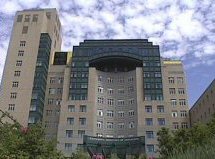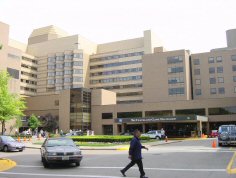|
Overview of the Neuroscience Clerkship |
Welcome to the Neuroscience Clerkship. This page will
review the basics and organization of the clerkship. All
third year Case medical students will rotate in the
Neuroscience clerkship as part of their required core.
The clerkship is four weeks in length.
|
|
Clinical Rotations
Student will be assigned to one of seven clinical sites.
The clinical sites and their rotations are described
here.
Students have the option of requesting an adult or
pediatric experience as well as a medical or surgical
one. Prior to the start of the clerkship,
students should contact the
Neuroscience clerkship coordinator,
Kristen Stacy,
preferably by e-mail, with their first and second
preferences for clinical assignments. Please request an
e-mail confirmation back to ensure your request has been
received.
Assignments are made on a first come, first serve basis.
All efforts will be made to accommodate each student's first or second request. |

University Hospital Neurology
Ward Service
University Hospital Neurology
Consult Service
University Hospital
Neurosurgery Service |

Cleveland VA Medical
Center Neurology Service |

Rainbow Babies and Children's Hospital
Pediatric Neurology Service
|
|

MetroHealth Neurosurgery Service |

Cleveland Clinic Neurology Service |
Teaching Program
All students will have responsibilities for inpatient care under the
supervision of either Neurology or Neurosurgery house officers and attendings. In
addition, students will attend outpatient clinics every week. However, since
the rotations are diverse, students will be exposed to different patient
populations and clinical problems depending on which clinical rotation they are
assigned.
However, all students will receive the same core didactic teaching material.
Each Thursday, students are excused from their clinical rotations to attend the
Neuroscience Didactic Teaching sessions. These sessions are intended to cover
core material that every student needs to know about neurology and neurosurgery.
The Thursday schedule follows:
|
|
Neurosurgery Demonstrations
10:00 - 11:00 am
RBC Room B501 |
|
Neurology Clinical Vignettes
11:00 - 12:00
12:30 - 1:30 p.m.
Hanna House 5 Conference Room
|
|
Neurosurgery Lecture Series
1:30 - 2:30 p.m.
Hanna House 5 Conference Room |
|
Chairman/Professor Rounds
2:30 - 3:30 pm.
Hanna House 5 Conference Room |
|
CPC (Neuropathology)
4:00 - 5:00 p.m. (1st and 3rd weeks)
Pathology Basement Auditorium
Morbidity and Mortality
Conference
4:00 - 5:00 p.m. (2nd week)
Hanna House 5 Conference Room
Outpatient Neurology Conference
4:00 - 5:00 p.m. (4th week)
Hanna House 5 Conference Room
|
Neuroscience Written Examination
At 8:00 a.m. the last Friday of the Clerkship, students
report to the School of Medicine electronic testing
center (E324) to take the Neuroscience Written
Examination. This is a 100 question multiple choice test
written by the Clerkship Directors. The examination is
based on the
Learning Objectives and covers material
from the Thursday teaching sessions.
Following the examination, students will discuss the
examination with the Clerkship Director and grade their
own test. This allows the examination to function as a
learning tool as well as an evaluation assessment.
|
Evaluation Policy
Students will be graded by an objective evaluation
strategy using a point system for both their clinical
rotations and the neuroscience examination. The Medical
School Clinical Evaluation form is utilized for the
clinical evaluation with points assigned to each
category. Both the attending physician and senior
resident on the service will evaluate each student. If
there is more than one attending physician or senior
resident, the results for each will be weighed in
proportion to the time spent together. If a student's
exposure to an attending or senior resident is too
minimal (i.e., < 1 week), their evaluation will not be
included.
The total clinical score (190 points possible) will be
added to the neuroscience examination score (100 points
possible). Final grades are then defined as follows:
Honors: 237 points or greater
Commendable: between 175 and 236 points
Satisfactory: between 134 and 174 points
In order to pass with a satisfactory grade, the
student must meet all clerkship expectations and must
score a 58% on the Neuroscience test.
There are several ways to obtain a commendable grade
from the combination of the clinical and neuroscience
test components. This grade range is designed so that if
the student is above or meets all clerkship expectations
(>50% above) and scores an 80% on the Neuroscience test,
they will obtain a commendable grade.
Likewise, there are several ways to obtain an honors
grade from the combination of the clinical and
neuroscience test components. This grade range is
designed so that if the student is exceptional or above
all clerkship expectations (>50% exceptional) and scores
an 85% on the Neuroscience test, they will obtain an
honors grade.
There is no grading on a curve and no pre-set
determination of how many students should receive each
grading rank. Accordingly, if all students do honors
work, all students will earn an honors grade in
Neuroscience, and so forth for the other grades as well.
Lastly, each attending and resident will write formative
and summative comments on each student. The summative
comments are intended to be used by the Dean's letter
that are used when applying for residency. |